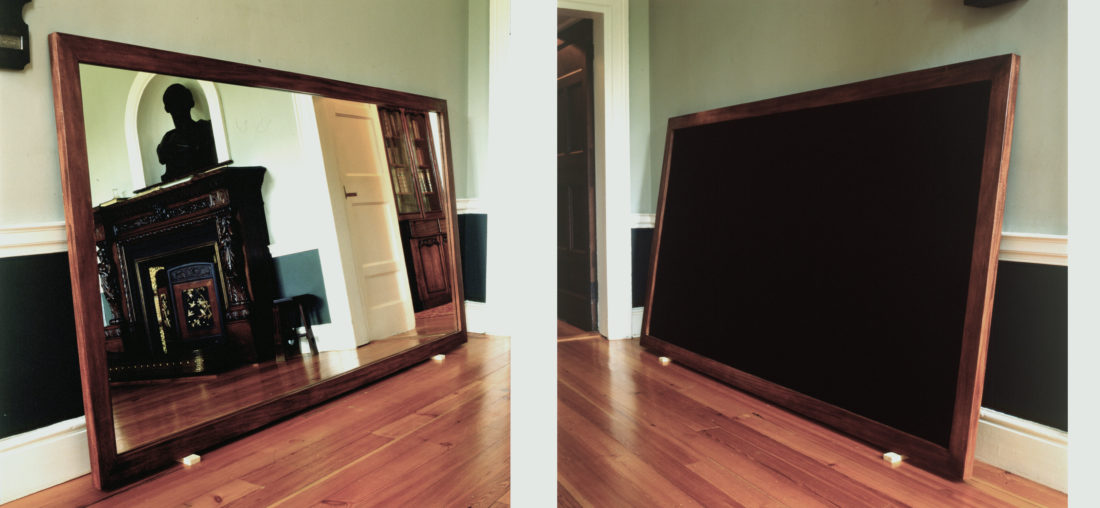A site-specific installation at The Pearse Museum, St Enda’s, Rathfarnham, Dublin which explored landscape, ideology and representation in the context of Padraig Pearse and the museum.
Padraig Pearse was an Irish teacher, barrister, poet, writer, nationalist and political activist who was one of the leaders of the Easter Rising in 1916 and was subsequently executed by British Military Forces for his role in the rebellion.
Pearse Museum and St Enda’s Park was where Patrick Pearse lived and ran his innovative Irish-speaking school, Scoil Éanna, between 1910-16. The site known as ‘The Hermitage’ was originally built by Edward Hudson, State Dentist, who signed a lease on the lands in 1786.
A framed mirror and blackboard (each 244 x 122 cm) stand in the foyer of the Pearse Museum separate from the main installation. Each was positioned opposite each other, sitting on the floor, leaning against the wall. These objects act as ‘primers’ to the substantive Projective Techniques installation – both mute ‘dumb’ surfaces that rhetorically speak to the shifting functions of the building over time – the blackboard in relation to the school, and the mirror relating to the museum as mode of representation.
The museum collection includes a Magic Lantern which once belonging to the Pearse family, and which was used as an educational tool in Scoil Eanna. (The Magic Lantern is form of slide projector popular during the period which projected two-inch square glass photographic slides, often hand-tinted, and commercially produced for domestic and educational use.) As part of the installation this artefact was re-located from its usual position in the museum to a large empty space. On a wall across from the Magic Lantern wall drawing was exectued in black tape which was based on one of the glass slide images (Slide No. 47 Upper Lake Killarney, Ireland, which was visible in the projector gate as part of the installation.)
The wall drawing is a kind of linear version of this landscape doubled and mirrored in a reference to Rorschach Ink blot tests. These now rarely used, but often parodied, these tests derive from psychoanalytic psychology where such projective techniques were intended to uncover such unconscious desires that are hidden from conscious awareness. The phrase also literally refers to the optico-mechanics of the magic lantern and the lens, and the role of optical metaphors in culture and ideology. The reference is deployed within the work to suggest the role of landscape within the nationalist imagination.
The other element in this space is a text applied to one of the windows in the centre of the opposite wall. This window faces out onto a French style formal garden, recalling the origins of the architecture as a Georgian manor house, before it functioned as Pearse’s school and later as a museum. The view here is of a formal garden of French design.
The text is a quote from the diary of Padraig Pearse’s sister Mary Brigit, recalling an incident in rural Connemara in the West of Ireland in 1913:
“Once Padraig brought down a cinematograph operator to Connemara and gave an entertainment in an adjancent school. But first of all he provided a plentiful supply of barn-bracks and sweets for the children. It was the first time that anything like it had ever been seen in the district and many funny remarks were passed thereon. One old woman tried hard to get behind the screen to see the real people. Her remarks should be quoted in Irish to give the real full value. Padraig had beautiful rural scenes shown”
The quote also speaks to relationship with landscape in the romantic nationalist imagination, where Pearse idealised the pure Gaels of rural Connemara, the anecdote describes a quintessential moment of where the metropolitan sophisticate confronts the naïve native with illusionistic representation of reality, and where with patronising comedic results follow.
The details of the story follow closely the structure of some of the earliest films, where the audience reaction was as important as what happened on the screen. Audience reaction to the Lumeries Brothers first Actualités films, such a scene of train emerging from the tunnel, reportedly resulted in patrons fleeing for safety. [1] The story by Pearse’s sister bears remarkable similarities to William Edison’s 1902 film Uncle Josh at the Moving Picture Show where the eponymous country rube attending a vaudeville theatre screening of a film cannot distinguish between representation and reality, ending in Uncle Josh tearing down the fabric screen.
[1] See Tom Gunning “Cinema of Attractions: Early Film, Its Spectator and the Avant-Garde.” Wide Angle, Vol. 8, nos. 3 & 4 Fall, 1986. Gunning’s concept of the “cinema of attractions” has tried to relate the development of cinema to forces other than storytelling, such as new experiences of space and time in modernity, and an emerging modern visual culture. Mary Bridget Pearse is writing at the end of what Gunning calls the period narrativization of the cinema between 1907 to 1913 when theatre and narrative overcome spectacle and other impluses which are supressed and only to find expression in avant-garde.

